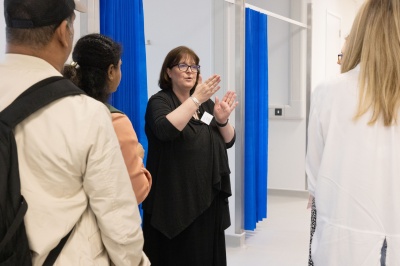Why do I need IVF treatment?
IVF Treatment is one of the most challenging things you will ever do. BCRM are here to provide you with the care, expertise and the latest medical technology to provide you with the best chances of conceiving and the utmost care and support every step of the way.
Below is a break down of why you might require this treatment:
- You have been diagnosed with unexplained infertility
- Your fallopian tubes are blocked
- Other techniques such as fertility drugs or intrauterine insemination (IUI) have not been successful
- A male partner has fertility problems but not severe enough to require intra-cytoplasmic sperm injection (ICSI)
- You are using your partner’s frozen sperm in your treatment and IUI is not suitable for you
- You are using donor eggs in your treatment
There are many other things which could stop you conceiving naturally. If you have been trying to conceive for over six months naturally or without contraception, we recommend booking an appointment with your local GP.
Our Embryologists work out the exact amount of sperm needed, with the strongest sperm penetrating the egg to form an embryo as it would in the body. The embryos are then given the optimum environment in which to develop within the dish. Between three and six days after fertilisation, the embryos will be transferred back into the woman’s uterus (Embryo Transfer, ET).
Short and Long Protocol
There are two types of IVF cycle; long or short protocol. Most patients will do long protocol IVF. The short protocol or antagonist cycles are often suggested for patients who have a Polycystic ovarian syndrome, as this is used to reduce the risk of OHSS (ovarian hyperstimulation), a side effect of IVF. The protocol you will be on will be determined by one of our fertility specialists at your consultation.
Medication for both protocols will start on cycle day 19.
Embryo Development
Once in the laboratory our team monitor the development of embryos every day. With IVF, the team will check the embryos each day under a microscope, which involves removing them from the incubator for a brief period, their development is then recorded and helps the team make a 'grading' to determine the quality of the embryo.
Here at BCRM we also offer the EmbryoScope+ which is the very latest in incubator technology. The incubator has a built-in camera, which captures images of your embryos several times an hour, therefore, instead of viewing embryos once a day the Embryoscope+ allows us to continuously assess the embryos and choose the best ones in preparation for transfer.
You can find out more about the EmbryoScope+ here
Below is a video from the EmbryoScope+ of a blastocyst developing from IVF treatment:
How long does it take?
From your consultant appointment to the results of the pregnancy test, your treatment could take approximately nine weeks.
If you undergo a long protocol cycle you will make about six visits to the clinic.
If you have a short protocol cycle, this will take an approximate of five weeks, and should have five visits to our clinic.
(Please note, every person we treat will have different requirements and might take longer than stated above.)
IVF Success Rates
Find out more about our IVF success rates here
IVF Process: The Six Steps
IVF treatment is a six steps programme, which starts with suppressing your natural monthly hormone cycle to having your embryo transferred. Depending on your personal requirements this might change. Below is a detailed breakdown of what’s involved.

1. Suppressing the Natural Cycle
As a first step, you will be given medication to suppress your natural monthly hormone cycle. This will be a tablet and depending on your treatment protocol an injection which you can administer yourself daily. This medication treatment continues for about two weeks.
2. Boosting Egg Supply
After your natural cycle has been suppressed, you will be given a type of fertility hormone known as a gonadotrophin. You will usually take this as a daily injection for around 12 days. The hormone will increase the number of eggs you produce.
3. Ultrasound Scanning
At BCRM we will monitor your progress throughout the drug treatment through vaginal ultrasound scans and, possibly, blood tests. Between 34 and 38 hours before your eggs are due to be collected you will be given a hormone injection to help your eggs mature. This is likely to be human chorionic gonadotrophin (hCG).
4. Collecting the Eggs (Transvaginal Oocyte Recovery)
A hollow needle is attached to the ultrasound probe and is used to collect the eggs from the follicles on each ovary. Afterwards, you may experience some cramps, feel a little sore and bruised and/or experience a small amount of bleeding from the vagina. Once your eggs have been collected, you will be given pessaries, injection or gel to help prepare the lining of your womb for your embryo transfer.
5. Fertilising the Eggs
Your eggs will be mixed with your partner’s or the donor’s sperm and cultured in the laboratory for 16–20 hours after which they are checked for signs of fertilisation. Those that have been fertilised (embryos) will be grown in the laboratory incubator for up to six days. The embryologist will monitor the development of the embryos and the best will then be chosen for transfer.
6. Embryo Transfer (ET)
During the procedure, a doctor or nurse will insert a speculum into your vagina. This is similar to having a cervical smear taken when a speculum is used to hold the vagina open, so the cervix is visible. A fine tube (catheter) is then passed through the cervix, normally using ultrasound guidance. The embryos are passed down the tube into the womb; this is normally a pain-free procedure.
IVF at BCRM
from £3999Fill out the form below to find out more






